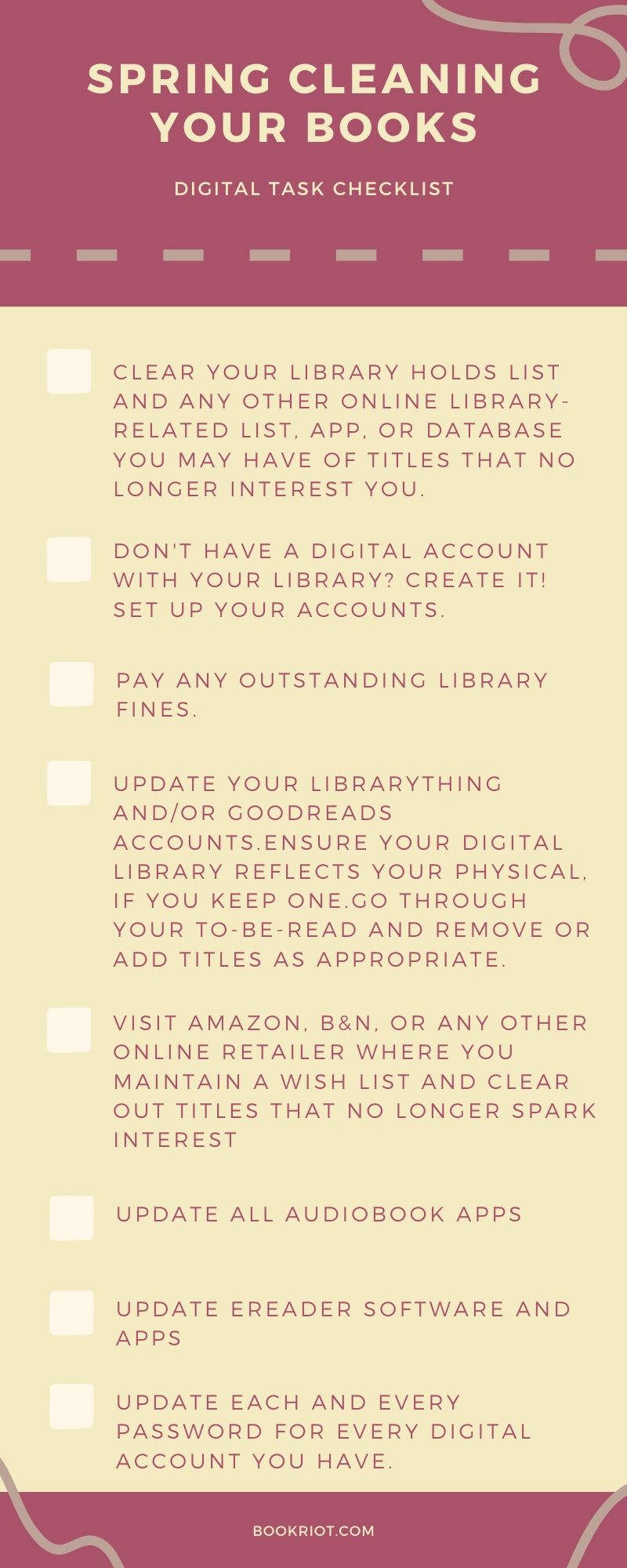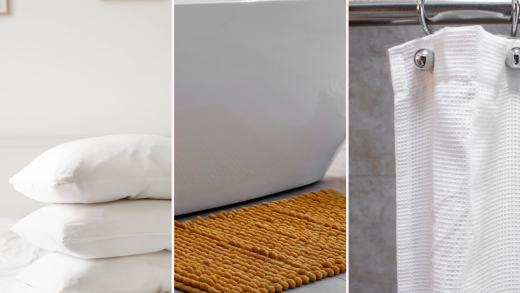Whether or not it’s bright and sunny in your neck of the woods yet, for those of us in the Northern Hemisphere, it’s spring according to the calendar. There’s a reason people go deep into spring cleaning mode: after months inside, it feels so good to open the windows, to get some fresh air, and to shift things out that no longer serve. I always used to get this tremendous desire to weed collections when working as a librarian during the spring, and one of the reasons we weed is that by removing the books that aren’t serving the community anymore, we’re able to make everything else stand out better. Outside library life, I still get the urge to tidy up my shelves, thus it seemed about time to pull together a guide to spring cleaning your books.
I’m a huge fan of Apartment Therapy’s annual January Cure program. Every day during a set period in January, a daily task shows up in your inbox for what to clean in your home. Some days it’s as simple as cleaning a single drawer. Other days, it’s a monumental task such as finding all of the loose papers in your entire house and sorting through them. Taking that as my inspiration, as well as my own need to tidy up, find below a series of tasks that will help you clean up your shelves.
Each of these can be done alone—give yourself a single task per day, depending on the time you’ve got available—or you can do many tasks at once. There are subtasks within the tasks, and again, feel free to take them day by day or all at once. Not all of these will be relevant for everyone and that’s okay. Skip ’em.
In addition to the lists below, I’ve also embedded some fun graphics for you to save or print and check off as you go. Those are abbreviated versions of the text, perfect for referencing during your work.
Tasks are divided by physical spring cleaning tasks and digital. There will be crossover among the two, but I find it easier to conceive of all the things worth cleaning by doing so.
Get ready. Get set. It’s go time!
The Ultimate Guide to Spring Cleaning Your Books
Physical Tasks
- Remove every book from each shelf in your space.
- Dust bookshelves.
- Dust the covers and edges of every book with a soft towel. Here’s a handy guide on how to clean your books.
- Go one by one through your books and decide whether to keep it, donate it, sell it, or recycle it. Create an additional pile within each of those for books that may need repair, as well as a pile for books that do not belong to you. Need help determining what books should go where? Here’s a handy guide.
- Assess any books you’ve inherited and determine whether they’re worth keeping, donating, selling, or recycling. Books which may be worth something should be set aside separately for assessment by a rare books expert.
- If you want to keep a book that’s beyond repair, put it in the recycle pile and note that it’s a book you wish to repurchase.
- Repair all books and return to their respective piles. Here’s a handy guide for how to fix book binding, as well as a book repair 101.
- Research where you’d like to donate your books, as well as where you’d like to sell used books.
- Clear time in your schedule to deliver those books to their respective new homes and take them.
- Schedule an appointment with a rare book expert for heirloom or historical books you may wish to sell to collectors.
- Create a single space in your home to house and organize your library books. Don’t buy anything fancy to do this. Grab a reusable bag or storage box and let that be a permanent landing spot for the materials you borrow from libraries.
- Return books that do not belong to you.
- Recycle books that you’ve put in a pile for recycling.
- Purchase new copies of books you wish to keep but cannot be repaired.
- Assess what books will still be in your possession, and purchase additional bookshelves or other furniture or accessories which will house all of those books, plus future acquisitions.
- Assemble bookshelves.
- Clear space for where new book storage will be. If your books will be housed in different parts of your home (e.g. cookbooks in the kitchen, fitness books where you work out, etc.).
- Books you’ve elected to keep should be reshelved. Here are some ideas for how to organize bookshelves with a lot of books, as well as how to store books safely.
- If you keep a commonplace book or notebooks with favorite quotes, lines, commentary on books, etc., pull them all together and give them a single home.
- Keep a ton of blank notebooks? Pool them all together in one place.
- Scour your physical to-be-read lists and remove titles that no longer interest you. Add any new books to the list.

Digital Tasks
- Clear your library holds list and any other online library-related list, app, or database you may have of titles that no longer interest you.
- Don’t have a digital account with your library? Create it! Set up your accounts.
- Pay any outstanding library fines.
- Update your LibraryThing and/or Goodreads accounts.
- Ensure your digital library, if you keep one, reflects your physical library.
- Go through your to-be-read and remove or add titles as appropriate.
- Revisit shared quotes and remove those you no longer wish to hold on to, as well as add those you’ve been meaning to add.
- Write reviews of outstanding books that you’ve meant to and haven’t. Delete “review to come” or other similar language from books you have no time or interest in writing one for from those titles in your library.
- Visit Amazon, B&N, or any other online retailer where you maintain a wish list and clear out titles that no longer spark interest or move them from those lists to centralized lists on Goodreads/LibraryThing/your library account.
- Open your audiobook apps and update them if necessary.
- Download audiobooks on the cloud you wish to read and remove or archive those which are finished.
- Leave reviews of titles, if appropriate.
- Update your ereader’s software, as well as any apps you regularly use.
- Download books on the cloud you wish to read and remove or archive those which are finished.
- Leave reviews of titles on retailer sites or Goodreads/LibraryThing as appropriate.
- Update each and every password for every digital account you have.









